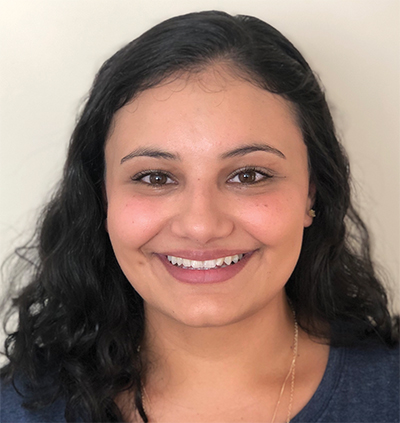Using crystallography to answer questions of structure and function
Caroline Soliman discovered her love for lab work as an undergraduate studying biomedical science at Monash University in Melbourne, Australia. She thrived on doing hands-on work to answer the question “What’s my goal, and how am I going to get there?”
 The findings of Caroline Soliman’s team are crucial for understanding the function of carbohydrate-binding human antibodies as potential microbial therapeutics.
The findings of Caroline Soliman’s team are crucial for understanding the function of carbohydrate-binding human antibodies as potential microbial therapeutics.
Now a graduate student at the Royal Melbourne Institute of Technology, or RMIT, Soliman won a 2019 Journal of Biological Chemistry/Herbert Tabor Young Investigator Award for her work on the structural characterization of antibody candidates that recognize carbohydrates for immunotherapy for infection.
Soliman earned an honors degree at Monash University through the Burnet Institute. For her thesis, she worked with , now her dissertation mentor, to develop a peptide-based inhibitor to mimic the binding of a microbial protein to immunoglobulin A. The project sparked an interest in crystallography.
“I gained an appreciation for the importance of structure in terms of function,” she said.
After a short break from research, Soliman returned to Ramsland’s lab for her doctoral training at RMIT. Together, they crafted a project with translational benefits and an international collaboration with Gerald Pier of Harvard Medical School that would give Soliman the chance to develop her crystallography skills.
“My supervisor has been very supportive and encouraging,” she said, adding that Ramsland helped her navigate the roadblocks of learning crystallography, teaching her how to collect data from the Australian Synchrotron and walking her through the process of solving a crystal structure.
When not solving crystal structures, Soliman can be found in the kitchen baking cakes, tarts and other sweet treats. She also enjoys reading, swimming at the beach and spending time with her family in Melbourne.
After completing her Ph.D., Soliman hopes to pursue a career in research and to teach immunology.
“It’s really important to do something you enjoy,” she said.
Fighting antibiotic resistance with antibodies
Antibiotics are used to fight bacterial infections, but antibiotic resistance has created a need for alternative therapies. Many of the antibiotic-resistant bacteria prioritized for therapeutic development are known to form biofilms, sticky aggregations of microbes that act as an additional barrier against antibacterial therapies.
Therapeutic antibodies are a strong candidate to overcome both antibiotic resistance and barriers such as bacterial biofilms. Humans typically develop protective antibodies to bacterial carbohydrates as a result of infection, so researchers have focused on carbohydrate-binding antibodies. Specifically, the human antibody F598 is being tested in the clinical setting because it can elicit protective activities after binding to the microbial carbohydrate poly-N-acetyl-D-glucosamine, or PNAG, which is a polymer of N-acetyl-D-glucosamine, or GlcNAc, units.
To understand how this antibody targets PNAG, Caroline Soliman and colleagues defined the structural basis for recognition of PNAG by F598. They determined crystal structures for the antibody-binding fragment, or Fab, of F598 and its complexes with two carbohydrates, GlcNAc and a PNAG oligosaccharide. They found that the Fab binds to extracellular polysaccharide in biofilms and to PNAG on the surface of Staphylococcus aureus.
This was the to report the structural basis for human antibody recognition of PNAG.
Enjoy reading 91Ӱ��Today?
Become a member to receive the print edition four times a year and the digital edition monthly.
Learn moreGet the latest from 91Ӱ��Today
Enter your email address, and we’ll send you a weekly email with recent articles, interviews and more.
Latest in People
People highlights or most popular articles

Fliesler wins scientific and ethical awards
He is being honored by the University at Buffalo and the American Oil Chemists' Society for his scientific achievements and ethical integrity.

Hope for a cure hangs on research
Amid drastic proposed cuts to biomedical research, rare disease families like Hailey Adkisson’s fight for survival and hope. Without funding, science can’t “catch up” to help the patients who need it most.

Before we’ve lost what we can’t rebuild: Hope for prion disease
Sonia Vallabh and Eric Minikel, a husband-and-wife team racing to cure prion disease, helped develop ION717, an antisense oligonucleotide treatment now in clinical trials. Their mission is personal — and just getting started.

91Ӱ��members recognized as Allen investigators
Ileana Cristea, Sarah Cohen, Itay Budin and Christopher Obara are among 14 researchers selected as Allen Distinguished Investigators by the Paul G. Allen Family Foundation.

AI can be an asset, 91Ӱ��educators say
Pedagogy experts share how they use artificial intelligence to save time, increase accessibility and prepare students for a changing world.

91Ӱ��undergraduate education programs foster tomorrow’s scientific minds
Learn how the society empowers educators and the next generation of scientists through community as well as accreditation and professional development programs that support evidence-based teaching and inclusive pedagogy.

